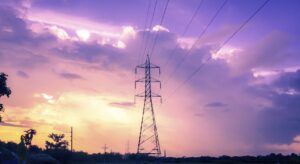Wind, unlike burning fuel, is a source of renewable, affordable and clean energy, the use of which does not result in the emission of greenhouse gases into the atmosphere. Thus, wind energy creates far fewer environmental problems compared to traditional non-renewable energy sources.
The average annual power generated by a wind generator appears to be approximately constant. However, the power level in shorter time intervals can fluctuate greatly. To ensure a stable power supply, wind turbines must be used in combination with other energy sources. Increasing the share of energy generated by wind power plants requires the modernization of the power line network, and leads to a consistent displacement of traditional generating capacity.
Wind farms consist of many individual wind turbines interconnected into a single grid. Onshore wind farms are an inexpensive source of electricity, and often provide a viable alternative to coal or gas-fired CHP. Offshore wind tends to be more stable and stronger than onshore, but the construction and maintenance costs of offshore wind farms are much higher. Small onshore wind farms can provide power to remote and isolated facilities and settlements.
The principle of wind turbine operation is quite simple. The wind makes the two or three-bladed turbines rotate, driving the main shaft, to which the generator rotor is connected. The rotation of the rotor leads to the generation of electricity.
A typical electrical scheme of a wind turbine generator contains a generator, batteries and a charge controller. The generated alternating voltage usually goes to the local transformer station (which collects energy from all turbines), where it is converted to higher voltage and transmitted through a cable or overhead line to another transformer station, where simple consumers are already connected. Transformer stations are needed to match the voltage of wind turbines with the grid.
If you dig deeper, it turns out that wind is actually a form of solar energy and is the result of uneven heating of the atmosphere by the sun. The map of wind direction and strength is highly heterogeneous and depends on the terrain, the presence of vegetation and bodies of water. Wind energy is used for various purposes: navigation, flying kites and hang-gliders, electricity generation.
Turbines of horizontal wind turbines usually have two or three blades. These blades are driven in rotation by frontal air currents.
Industrial wind turbines range in capacity from 100 kilowatts to several megawatts. Large capacity wind turbines prove to be more economical and are combined into wind farms that deliver electricity to the grid. In recent years, there has been a significant increase in the number of large offshore and onshore wind farms in the United States. This has been done to maximize the wind energy potential of coastal regions.
Individual wind turbines of less than 100 kilowatts are used to power homes, telecommunications towers, pumping stations, etc. Small wind turbines are sometimes used in combination with diesel generators, batteries and solar panels. Such solutions are called hybrid solutions and are usually placed in remote locations that do not have their own power lines.
Currently, most turbines use variable speed generators combined with an intermediate power converter between the generator and the power collection system, which is the most suitable option for interconnection and provides the ability to shut down when the output voltage is low. Modern systems use either dual-powered machines or squirrel cage generators or synchronous generators.
Modern power systems face many problems, including the problem of excess capacity, which can be solved by implementing special measures: exporting and importing electricity to neighboring areas, changing water levels in the reservoirs of hydroelectric power plants, conversion of electric power into mechanical energy, limiting consumption, etc. With local wind turbines, this problem can be smoothed out.
In a wind farm, individual turbines are combined into a single complex with the help of a power collection system and information communication channels. The average output voltage for wind turbines is usually 34.5 kV. At the transformer station, this voltage is further increased for further transmission via high-voltage power lines.


